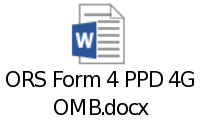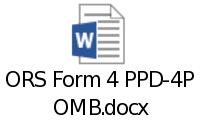Note to Reviewer of 1220-0189
Note to Reviewer - 1220-0189 nonsubstantive change request for the Occupational Requirements Survey(OCIOEdits20160411).docx
Occupational Requirements Survey (ORS)
Note to Reviewer of 1220-0189
OMB: 1220-0189
March 31, 2016
MEMORANDUM FOR: REVIEWER of 1220-0189
FROM: Bryandt Rose Dickerson
Division Chief, National Compensation Survey
Office of Compensation and Working Conditions
Bureau of Labor Statistics
SUBJECT:
Non-substantive Change Request for the
Occupational
Requirements Survey (ORS)
Clearance is being sought for the Bureau of Labor Statistics’ (BLS) Occupational Requirements Survey (ORS) program for revisions to some ORS questions that describe the mental and cognitive demands of work. The BLS plans to starting using these revised questions for collection in late May 2016. Information on ORS data collection was included in Part A, Section 12 of the most recent Office of Management and Budget (OMB) Clearance for ORS (1220-0189) which was approved on August 26, 2015. This clearance package covers the first three years of ORS collection which started in 2015 and ends in 2018.
These changes are the result of many debriefings of our field economists; testing of revised cognitive questions in FY 2015 (approved by OMB on May 1, 2015); and some initial collection results from 2015. The FY 2015 test provided further information on respondents’ perception of the wording. As a result of this information , a collaborative effort was undertaken by BLS and the Social Security Administration (SSA) to revise the cognitive questions.
Most ORS data are collected by conversational interviews. When asking questions, field economists do not rely on a scripted interview, instead, they ask probing questions to obtain the information.
BLS expects that the revised cognitive questions will not create any additional respondent burden, beyond the burden hours already approved. The revised cognitive questions have changed some of the response options. BLS field economists complete the forms as note taking devices during the data collection interviews. The collection forms are not questionnaires that respondents complete. Attachment A documents the questions that have changed.
Approval is sought for revising forms OMB_ORS_Form_Gov_4PPD-4G and OMB_ORS_Form_Priv_4PPD-4P. (Attachments B and C)
If you have any questions about this non-substantive change request, please contact Paul Carney at 202-691-5180 or e-mail at [email protected], or Bryandt Dickerson at 202-691-7744 or e-mail [email protected]
Attachment A: Currently approved cognitive questions and revised cognitive questions
Decision-making
-
Existing Question/Response Wording
Revised Wording Request
What type of decision-making is required to perform the tasks of this occupation?
Little or no decision-making.
Makes straightforward decisions from set choices in familiar situations.
Makes straightforward decisions by assessing situations and possible outcomes.
Makes decisions by assessing uncertain or conflicting situations.
What is the highest level of independent judgment a worker is expected to use to perform the tasks of this occupation?
Employee uses independent judgment to select from a limited number of predetermined actions.
Employee uses independent judgment to determine the most appropriate course of action in situations that do not have set responses.
Employee uses independent judgment to make decisions by choosing from a large number of possibilities in situations where a high degree of uncertainty or complexity may exist.
Supervision
-
Existing Question/Response Wording
Revised Wording Request
What type of supervision does this occupation have?
Detailed instruction and help are always provided. Frequent and thorough review of work.
Detailed instruction and help are provided when needed. Review of work may be frequent and emphasizes the quality of completed assignments.
General instructions provided and help given when requested. Review of work is occasional and emphasizes accomplishments of broad work objectives.
Only broad objectives are provided. Review of work is infrequent and focuses on effectiveness.
How frequently is work checked for workers in the occupation?
More than once per day.
Once per day.
At least once per week, but less than daily.
Less than weekly.
Pace
-
Existing Question/Response Wording
Revised Wording Request
What is the pace of the work?
Slow: Unhurried and workload is constant.
Moderate: Steady and workload is constant.
Fast: Rapid and workload is constant.
Variable: Markedly faster and slower periods that are driven by changing workload demands.
Are there faster and slower periods of work?
Yes
No
What is the fastest pace performed?
Rapid with no periods of waiting.
Steady with rare periods of waiting.
Unhurried with much time spent observing or waiting, rushed periods rarely or never occur.
Control of Work Pace/Flow
-
Existing Question/Response Wording
Revised Wording Request
What controls the pace of the work?
Work-driven: Work process drives the pace; the worker must keep up and continuously meet production standards.
Worker-driven: Worker controls the pace.
Can a worker intervene and control the flow of work?
Yes. The worker can change the priority of work tasks or the amount of time allotted to complete them.
No. The work is primarily driven by business processes, production line speed, or customer demands.
Adaptability
-
Existing Question/Response Wording
Revised Wording Request
An occupation’s work routine consists of its work tasks, work schedule, and location of work as it is generally performed. We are interested in how frequently work tasks, schedule, and location change.
Select the statement that best describes how frequently the work routine changes for this occupation.
How often do work tasks/work schedule/work location change in this occupation?
Rarely or never changes (Does not change unless it is permanent.)
Sometimes changes (May temporarily change several times a year to meet business needs including seasonal variations.)
Often changes (Changes on an unpredictable basis to meet business needs.)
Always changes (Change is frequent and driven by forces external to the company, such as emergency response.)
Work Tasks are the regular duties of an occupation. How often do work tasks change in this occupation?
At least once per day.
At least once per week, but less than daily.
At least once per month, but less than weekly.
Less than monthly, including never.
Work location is the physical site where work is performed. How often does the work location change in this occupation?
Does not change unless it is permanent.
Changes up to four times a year.
Changes more than four times a year.
Work Schedule is the work hours and days for the occupation set by the employer. Does the work schedule change in this occupation?
Yes
No
Personal Contacts
-
Existing Question/Response Wording
Revised Wording Request
Regular Contacts: People with whom there is an established working relationship.
Other Contacts: People with whom there is no established working relationship.
How often does this occupation require verbal interaction (work related) with: Regular Contacts? Other Contacts?
Ongoing (Constantly, every few minutes)
Several times an hour (More than once per hour, but not constantly)
Hourly or Semi-Hourly (More than once per day, but not more than once per hour)
Daily or Less (No more than once per day; includes never)
What type of work-related interactions does this occupation have with: Regular Contacts? Other Contacts?
Very structured (Exchanging straightforward, factual information)
Structured (Coordinating work with others; solving recurring problems with cooperative parties)
Semi-structured (Some gentle persuading or soft-selling; discussing)
Unstructured (Influencing; hard-selling; asserting control in situations)
Very unstructured (Resolving controversial or long-range issues; defending; negotiating)
Regular Contacts: People with whom there is an established working relationship.
Other Contacts: People with whom there is no established working relationship.
How often does this occupation require verbal interaction (work related) with: Regular Contacts? Other Contacts?
Constantly, every few minutes.
More than once per hour, but not constantly.
More than once per day, but not more than once per hour.
No more than once per day; includes never.
What type of work-related interactions does this occupation have with: Regular Contacts? Other Contacts?
Exchanging straightforward, factual information.
Coordinating work with others; solving recurring problems with cooperative parties.
Some gentle persuading or soft-selling; discussing.
Influencing; hard-selling; asserting control in situations.
Resolving controversial or long-range issues; defending; negotiating.

Attachment C

| File Type | application/vnd.openxmlformats-officedocument.wordprocessingml.document |
| File Title | Nonsubstantive Change Request |
| Subject | SSA Test surveys approval |
| Author | Paul Carney |
| File Modified | 0000-00-00 |
| File Created | 2021-01-24 |
© 2025 OMB.report | Privacy Policy